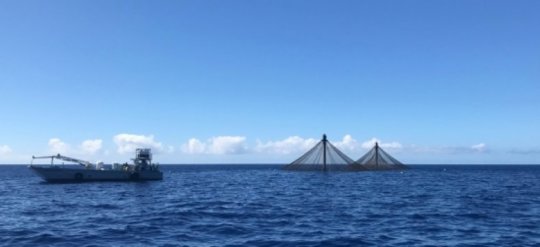[ad_1]
There are only so many fish in the sea. And our appetite for seafood has already stressed many wild fisheries to the breaking point. Meanwhile, the planet’s growing population will only further increase the need for animal protein, one of the most resource-intensive types of food to produce.
With this in mind, a team led by researchers at UC Santa Barbara’s Bren School of Environmental Science & Management and the Marine Science Institute (MSI) looked at the feasibility of fish farming, or aquaculture, in the Caribbean. The team focused specifically on offshore mariculture — ocean-based operations done far from shore — which offers a promising alternative to land-based and coastal aquaculture, where space is limited and environmental impacts are often high.
The group discovered that even under conservative estimates, the region could produce over 34 million metric tons of seafood per year. This potential yield is more than two orders of magnitude larger than the region’s current seafood production. The results appear in the journal Nature Sustainability.
“The Caribbean has a large potential for off-shore mariculture,” said Lennon Thomas, the study’s lead author, who serves as a project researcher at MSI. “And meeting this potential can be accomplished by developing mariculture in a relatively small amount of ocean space.”
The researchers’ model predicts the region could produce 40 million metric tons of seafood in less than 1.5 percent of its countries’ exclusive economic zones. This is roughly half of the current global wild fisheries catch, Thomas said. Under current market conditions, the Caribbean could match its current seafood production by farming in just 179 square kilometers, or a mere 0.006 percent, of its marine space.
The team used cobia as their model species to estimate the Caribbean’s potential for commercial mariculture. Cobia is a premium fish with high market value that is well suited to farming in warmer waters. By combining elements like fish growth and habitat suitability with factors such as farm profitability and investment risk, the model developed by the group provided more realistic estimates of mariculture potential than if it had focused solely on biology or economics.
Thomas’s team considered socioeconomic and political factors to estimate the risk levels associated with investing in mariculture in each of the countries in the region, and came up with three scenarios. The first considered the results of farming in all suitable areas, while the second considered only areas that would be profitable over a 10-year timeframe, at a 10-percent discount rate. The third case mirrored the second, but with discount rates between 10 and 25 percent, based on the relative risk of investment estimated for each country.
Other papers have examined the physical and environmental factors influencing mariculture production potential on a global level, and researchers have previously applied bio-economic models to individual farms. But this new study is one of the first to analyze mariculture potential from a bio-economic angle at a regional level, explained Tyler Clavelle, a researcher at MSI and one of the paper’s coauthors. This gave the group a better understanding of the tradeoffs when developing farms in different areas within and across countries.
The results in all scenarios are promising. “Even accounting for the economics of an expensive operation like cobia farming, there are large areas of the Caribbean that could be profitable for off-shore aquaculture,” said Clavelle. Trinidad and Tobago and the Bahamas have the largest potential, with roughly 8,500 and 4,100 square kilometers, respectively, of area profitable for mariculture.
Insufficient capital presents one significant barrier to mariculture development in the Caribbean. Offshore mariculture is a relatively new, and therefore riskier, industry. Adding in the political and economic instability in certain parts of the region creates a higher risk for foreign investors, Thomas explained.
Thomas and Clavelle acknowledged that many people distrust aquaculture, believing it is bad for the environment. The researchers suspect the industry suffers this negative reputation because most of it is currently done on land or near the shore, where the farms’ feed, waste and other inputs can have negative impacts on surrounding ecosystems.
“Offshore mariculture overcomes many of the shortcomings and potential negative impacts that people often associate with coastal or inland aquaculture,” said Thomas. Deeper water and stronger offshore currents can prevent negative water quality impacts from aquaculture, while also avoiding sensitive nearshore habitats like coral reefs and seagrass meadows.
“Mariculture is very space efficient. And we have vast expanses of offshore ocean areas,” said co-author Sarah Lester, an assistant professor at Florida State University who completed her PhD at UC Santa Barbara. “So we can be really selective about where we locate fish farms, choosing locations where profitability is high and economic impacts are low.”
While the team looked specifically at cobia production in the Caribbean, the model could be applied to other species and regions as well. And the group intends to consider these in future work. They also plan to explore how climate change and increasing ocean temperatures will affect offshore aquaculture. Currently the researchers are investigating the impact of mariculture policy across the Caribbean on development trends, which promises insights that will complement their findings in this paper.
“In the Caribbean, like we see globally, seafood demand is increasing while many wild fisheries have been overfished,” said Lester. “Currently many Caribbean countries import large amounts of seafood — aquaculture offers a promising avenue for economic development and tasty, sustainable local seafood production.”
[ad_2]















